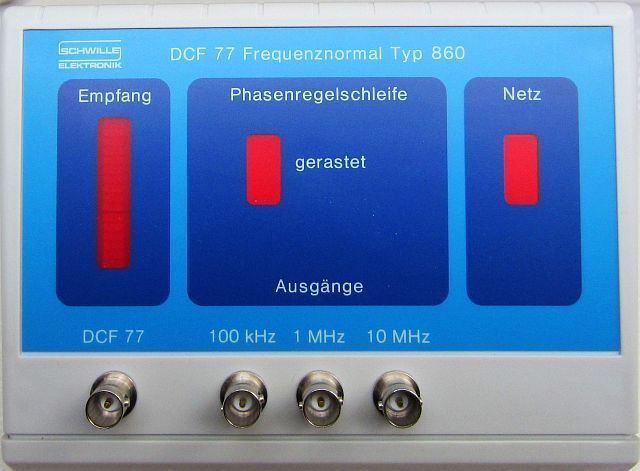
SCHWILLE DCF 77 FREQUENCY STANDARD

INTRODUCTION
If you deal a lot with equipment, for sure there comes a time that more accuracy will be an important factor. Many instruments are based on a reference source in the form of a 1 MHz or 10 MHz crystal oscillator without or with an oven, but is the frequency stable and correctly and how it can be calibrated. A reliable standard is not always available in the immediate vicinity.
A method that I used is to tune a receiver to a calibration signal of a 10 MHz beacon, monitor the oscillator and then adjust for zero beats. This requires some practice and it goes pretty good. It is not perfect, since often there is fading or the signal strength is insufficient with respect to other interfering sources. In short there is a need for a proper frequency standard.
SCHWILLE DCF 77 TYPE 860
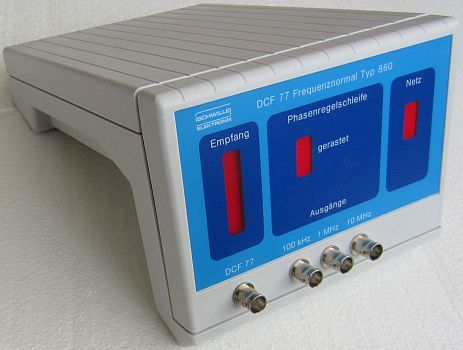
A professional frequency standard that is locked onto a transmitter, an atomic frequency or GPS is a valuable instrument. The cheapest is a Schwille type 860 that obtains its reference from DCF77's 77.500 kHz time signal near Frankfurt. To take advantage of the transmitter, the receiver must be within a radius of about 1500 km. This limits the applicability of the device to a part of Europe, but is suitable for the Netherlands.
The price of this frequency standard was not attractive to me because my Bulova temperature-controlled 10 MHz oscillator did well. Patiently wait was rewarded when unexpectedly even two Schwilles were offered in a ebay.de auction. So I'm (fig») purchased the instrument at a reasonable cost.
To my knowledge the device is produced in Austria ia put on the market under the brand name Schwille.
Technical Details:
Reception frequency: 77.500 KHz
Transmitter: Normal frequency transmitter DCF 77
Location: Mainflingen near Frankfurt am Main
Normal frequencies (outputs): 100 KHz, 1.000 MHz and 10.000 MHz
Level: TTL with Fan Out 30
Pulse Shape: Square wave with a 50:50 ratio
Control output: 2 Vpp signal from the transmitter
Accuracy: ................. Is dependent on the measurement time
.................................. 1 × 10 -7 at 1 second measurement time
.................................. 1 × 10 -8 to 10 seconds measurement time
.................................. 1 × 10 -9 for 100 seconds measuring time
.................................. 1 × 10 -11 at 12 hours (day / night tolerance)
Field strength indicator: red 20 Segment LED bars
Receiver Bandwidth: Narrow a broad internal ± 12 Hz crystal filter
Frequency Conversion: PLL with quasi-periodic divider
Attack: After switching on approx 30 seconds
Separate ferrite with 5 m cable
Antenna Bracket: Mounting with mounting bracket
Housing: Plastic housing h × w × d, 135 × 175 × 235 mm
Voltage: 230 Volts AC 50 - 60 Hz 5 VA
FERRIET ANTENNA
|
|
|
The standard is equipped with a separate ferrite antenna in a plastic housing. This is connected to the device with a 5 m long and thin shielded cable. The circuit is in resonance with a 2700 pF capacitor and is amplified and buffered by a BF245C FET. The signal is tapped from the drain through a 3 V supply line.
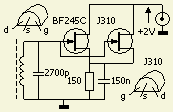
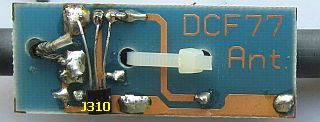
The reception in my shack was not optimal and more gain would be welcome. When comparing the parameters of BF245C and J310 the last is more suited. By way of experiment, I installed («fig) a J310 parallel to the BF245C. According to the LED indicator the received signal was maximum! The voltage on the supply line was 2 V, a sign that the current is increased. Presumably, with only one FET a same effect is achieved by reducing the source resistance, but I have not bothered to do anything to change.
BULOVA KRISTAL OSCILLATOR
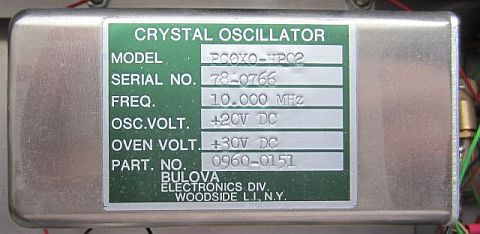
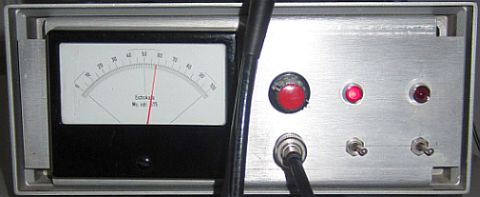
I used as reference source an (fig ») oven stabilized 10 MHz Bulova/HP crystal oscillator. The system is housed with a power supply in an emptied HP cabinet. The Bulova is an extremely stable product. Even if not permanently on or occasionally into action, after about 10 minutes the frequency is exactly 10 MHz. This is monitored with even more stable standards.
TYPE 860 IN ACTIE
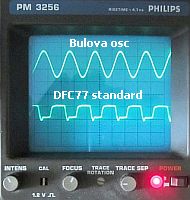
How the 860 device is functioning in practice? If its 10 MHz output and a 10 MHz crystal oscillator (here Bulova) are coupled to a double-ray oscilloscope, the figures are not moving if the two frequencies are exactly the same. If not, you need to calibrate the oscillator.
However, due to fading the 10 MHz locked output winds its way to a limited extent. In these circumstances I calibrate an oscillator to the centre of that "drift". Practice has proven that this is a good method. The Bulova stays unwavering if it is set on frequency.
SPLITTER
|
|
|
|
To feed various instruments with a stable 10 MHz time base a splitter with 4 outputs is used. The dingy box was purchased initially and stored for BNC connectors and possibly to encase a project. In a later stage the box was cleaned and polished and then it turned out to be a 3 MHz - 200 MHz professional splitter!
![]()